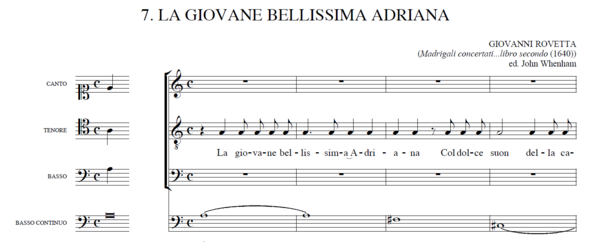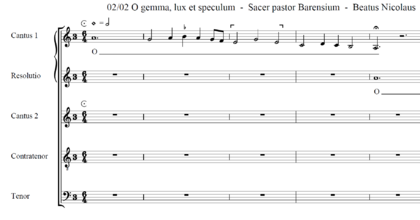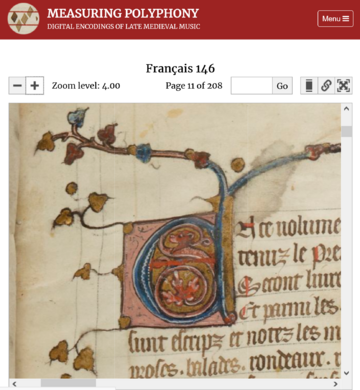Template:EVE Critical Editions: Difference between revisions
| (35 intermediate revisions by 2 users not shown) | |||
| Line 2: | Line 2: | ||
===ASCIMA: Archive of Seventeenth-Century Italian Madrigals and Arias=== | ===ASCIMA: Archive of Seventeenth-Century Italian Madrigals and Arias=== | ||
[[File:Rovetta-Arianna.PNG|600px|thumb|right|<small>From an edition of Giovanni Rovetta's madrigal "La giovane bellissima Adriana" (1640) in the ASCIMA repository.</small>]] | |||
Website: [http://www.ascima.bham.ac.uk ASCIMA] | Website: [http://www.ascima.bham.ac.uk ASCIMA] | ||
| Line 12: | Line 14: | ||
Website: [http://cpebach.org/ <i>C.P.E. Bach: The Complete Works</i>] | Website: [http://cpebach.org/ <i>C.P.E. Bach: The Complete Works</i>] | ||
This digital analogue of the printed set allows users to download complete scores. Critical notes are viewable online. All scores can be downloaded as PDFs by going to the "Contents of Series and Volumes" tab and selecting the work. Users seeking a work by catalogue number can consult the [http://cpebach.org/search.html "Search" tab]. Non-transferable performing parts can be ordered at the Performing Materials tab without cost on request. | This digital analogue of the printed set allows users to download complete scores. Critical notes are viewable online. All scores can be downloaded as PDFs by going to the "Contents of Series and Volumes" tab and selecting the work. Users seeking a work by catalogue number can consult the [http://cpebach.org/search.html "Search" tab]. Non-transferable performing parts can be ordered at the Performing Materials tab without cost on request. This series, which now includes links to facsimiles, the composer's autobiography, a catalog of his [https://loc.gov/item/ihas.200212334 <i>Nachlass</i>], and a scan of Alfred Wotquenne's [https://archive.org/details/thematischesverz00wotq/page/n3/mode/2up?view=theater thematic catalog], is nearing completion. | ||
===<i>Du Fay: Opera Omnia</i>=== | ===<i>Du Fay: Opera Omnia</i>=== | ||
| Line 20: | Line 20: | ||
Website: [https://www.diamm.ac.uk/resources/music-editions/du-fay-opera-omnia/ <i>Du Fay: Opera Omnia</i>] | Website: [https://www.diamm.ac.uk/resources/music-editions/du-fay-opera-omnia/ <i>Du Fay: Opera Omnia</i>] | ||
Alejandro Planchart's critical edition of all the works of Guillaume Du Fay is subdivided into eleven | [[File:Dufay_O-gemma.PNG|420px|thumb|right|super|<small>Opening of the online critical edition of DuFay's isorhythmic motet "O gemma, lux et speculum" from Panchart's edition of the <i>Opera Omnia</i>.</small>]] | ||
Alejandro Planchart's critical edition of all the works of Guillaume Du Fay is subdivided into eleven sections by musical/liturgical genre. The first three sections are currently available at the above link. All works are available in PDFs containing the edited music. | |||
===Gesualdo Online=== | ===Gesualdo Online=== | ||
| Line 26: | Line 28: | ||
Website: [https://ricercar.gesualdo-online.cesr.univ-tours.fr/ Gesualdo Online] | Website: [https://ricercar.gesualdo-online.cesr.univ-tours.fr/ Gesualdo Online] | ||
Gesualdo Online is a collaborative project designed to enable dynamic editing of the of the composer's works, which are noted for their intensely chromatic development. The project is based at the University of Tours. The organizers intend to show the editorial history of individual works by managing variants with MEI (the Music Encoding Initiative) and similar protocols. | Gesualdo Online is a collaborative project designed to enable dynamic editing of the of the composer's works, which are noted for their intensely chromatic development. The project is based at the University of Tours. The organizers intend to show the editorial history of individual works by managing variants with MEI (the Music Encoding Initiative) and similar protocols. As of April 2021, 222 works were available. | ||
===MARGOT=== | ===MARGOT=== | ||
| Line 35: | Line 37: | ||
===Measuring Polyphony=== | ===Measuring Polyphony=== | ||
[[File:Machaut_init.PNG|360px|thumb|right|<small>This illuminated initial from Guillaume de Machaut's "Dous viaire gracieus" is significantly enlarged.</small>]] | |||
[[File:Machaut_init.PNG| | |||
Website: [https://measuringpolyphony.org/ Measuring Polyphony] | Website: [https://measuringpolyphony.org/ Measuring Polyphony] | ||
<i>Measuring Polyphony</i> presents | <i>Measuring Polyphony</i> presents digitizations of polyphonic compositions written during the thirteenth and fourteenth centuries in mensural notation. In most cases these are linked to high-resolution images of the original manuscript sources. It offers new possibilities for mediating the scholarly and public experience of this music within its original context. It leverages the potential of the digital image repositories of music manuscripts and the community-based standards for encoding music notation of the [http://music-encoding.org/ Music Encoding Initiative (MEI)]. Two MEI encodings are provided--one for individual parts and one for a score. The work can also be viewed in modern notation, downloaded as a PDF, and played as a MIDI file. The use of the interoperable image framework [https://en.wikipedia.org/wiki/International_Image_Interoperability_Framework IIIF] facilitates the view of small details of the sources with many applications. | ||
<i>Measuring Polyphony</i> has three goals: | <i>Measuring Polyphony</i> has three goals: | ||
| Line 48: | Line 48: | ||
<li> It makes transcriptions and audio freely available online to performers, scholars, and the general public, presented alongside images of the original music manuscripts;</li> | <li> It makes transcriptions and audio freely available online to performers, scholars, and the general public, presented alongside images of the original music manuscripts;</li> | ||
<li> It encodes the medieval notation in a | <li> It encodes the medieval notation in a standardized machine-readable format so that the music data can potentially be be searched or analyzed using current tools, and through this interoperability make the data available to other websites and applications; and</li> | ||
<li> It makes the processes and tools for digitally encoding mensural polyphony in mensural notation freely available so that other stakeholders can easily and rapidly enlarge the dataset.</li> | <li> It makes the processes and tools for digitally encoding mensural polyphony in mensural notation freely available so that other stakeholders can easily and rapidly enlarge the dataset.</li> | ||
| Line 59: | Line 59: | ||
Website: [http://www.marenzio.org/ The Marenzio Online Digital Edition (MODE)] | Website: [http://www.marenzio.org/ The Marenzio Online Digital Edition (MODE)] | ||
This online digital edition of Luca Marenzio's secular music has been under development for several years. Mauro Calcagno and | This online digital edition of Luca Marenzio's secular music has been under development for several years. Mauro Calcagno and Laurent Pugin are the principal investigators. The musical sources are sixteenth-century partbooks that have been scanned (and "recognized') by Pugin's <i>Aruspix</i> software. Scores are assembled from the recognized parts. Demonstration works allow highlighting of textual variants, alternation between original and modern clefs, and navigation from section to section via text incipits. Metadata and textual rhythm patterns can be viewed in a separate window. | ||
===Neuma=== | |||
Website: [http://neuma.huma-num.fr/ Neuma] | |||
NEUMA is a digital library of music scores encoded in MusicXML and MEI. Its objectives are to provide online access to rare corpora and to demonstrate, with interactive search and analytic tools, how music notation can support advanced functionalities in the exploraton of digital scores. | |||
===Parzival (Digital Critical Edition)=== | ===Parzival (Digital Critical Edition)=== | ||
| Line 67: | Line 73: | ||
Owing to its long textual tradition (1210-1833) Wolfram von Eschenbach's medieval romance of the Arthurian knight <i>Parzival</i> and his search for the Holy Grail has an exceptionally complex history. Its sources include 16 intact manuscripts, 77 fragments, and a print from 1477. The narrative weaves together fragments of several textual traditions. The value of a new digital edition incorporating principal sources will enable the study of intertextual relationships to other epics circulated in manuscript. Elements of the new project include the creation of a catalog of manuscripts and verse-by-verse annotations. Richard Wagner read a version of the work in 1845 and began to think about composing an opera on the subject in 1857, but his opera <i>Parsifal</i> did not have its premiere until 1882. | Owing to its long textual tradition (1210-1833) Wolfram von Eschenbach's medieval romance of the Arthurian knight <i>Parzival</i> and his search for the Holy Grail has an exceptionally complex history. Its sources include 16 intact manuscripts, 77 fragments, and a print from 1477. The narrative weaves together fragments of several textual traditions. The value of a new digital edition incorporating principal sources will enable the study of intertextual relationships to other epics circulated in manuscript. Elements of the new project include the creation of a catalog of manuscripts and verse-by-verse annotations. Richard Wagner read a version of the work in 1845 and began to think about composing an opera on the subject in 1857, but his opera <i>Parsifal</i> did not have its premiere until 1882. | ||
=== | ===Web Library of Seventeenth-Century Music (WLSCM)=== | ||
[[File:Biffi_Asperges-me.PNG|600px|thumb|right|<small>Antonino Biffi: "Asperges me" from the Miserere mei, Deus," ed. Don Faber, Web Library of Seventeenth-Century Music, 2009.</small>]] | |||
Website: [http://www.sscm-wlscm.org/ Web Library of Seventeenth-Century Music (WLSCM)] | Website: [http://www.sscm-wlscm.org/ Web Library of Seventeenth-Century Music (WLSCM)] | ||
The Web Library of Seventeenth-Century Music (ISSN 2330-2429), which operates under the auspices of the [http://sscm-sscm.org/ Society for Seventeenth-Century Music], is a curated collection of music that is | The Web Library of Seventeenth-Century Music (ISSN 2330-2429), which operates under the auspices of the [http://sscm-sscm.org/ Society for Seventeenth-Century Music], is a curated collection of music that is otherwise unavailable. Most items in its catalog feature a "full volume" of works with an introduction and critical notes. Most publications come from French and Italian composers, with numerous Spanish items recently added (2021). Current holdings include cantatas (including <i>Lucrezia Romana</i>, Alessandro Scarlatti), canzonas (multiple composers), keyboard works and arrangements (R. Ayleward, 67 short pieces, with audio samples; J.-B. Lully, 250 pieces newly edited from scattered manuscripts), Lament for the Queen of England (A. Bertali), madrigals (Biagio Marini), motets (M.-A. Charpentier), and spiritual monodies (G. G. Kapsberger). Collectively these downloadable editions constitute the series <i>Monuments of Seventeenteenth-Century Music</i>. | ||
Latest revision as of 21:48, 5 October 2022
Editions listed here cite curated scores, usually with a critical apparatus (a description of the musical sources and a log of differences between the present score and the original one). Some offer performing parts or downloadable files from which parts can be created. Data files with which you can make your own edition of a score are included as appropriate. Some sites are under development. All are intended for expansion. Please note that EVE is limited to open-access materials.
ASCIMA: Archive of Seventeenth-Century Italian Madrigals and Arias

Website: ASCIMA Website: ASCIMA
The ASCIMA website, directed by John Whenham at Birmingham University (UK), provides full critical editions of entire volumes of secular vocal music which has been edited from printed part-books. Current holdings include madrigal collections by Tarquinio Merula, Claudio Monteverdi, Martino Pesenti, Giovanni Rovetta, Barbara Strozzi, and Giuseppe Valentini. Both single works and entire opuses can be downloaded as single files. Sound files are provided for each work.
C.P.E. Bach: The Complete Works
Website: C.P.E. Bach: The Complete Works
This digital analogue of the printed set allows users to download complete scores. Critical notes are viewable online. All scores can be downloaded as PDFs by going to the "Contents of Series and Volumes" tab and selecting the work. Users seeking a work by catalogue number can consult the "Search" tab. Non-transferable performing parts can be ordered at the Performing Materials tab without cost on request. This series, which now includes links to facsimiles, the composer's autobiography, a catalog of his Nachlass, and a scan of Alfred Wotquenne's thematic catalog, is nearing completion.
Du Fay: Opera Omnia
Website: Du Fay: Opera Omnia

Alejandro Planchart's critical edition of all the works of Guillaume Du Fay is subdivided into eleven sections by musical/liturgical genre. The first three sections are currently available at the above link. All works are available in PDFs containing the edited music.
Gesualdo Online
Website: Gesualdo Online
Gesualdo Online is a collaborative project designed to enable dynamic editing of the of the composer's works, which are noted for their intensely chromatic development. The project is based at the University of Tours. The organizers intend to show the editorial history of individual works by managing variants with MEI (the Music Encoding Initiative) and similar protocols. As of April 2021, 222 works were available.
MARGOT
Website: MARGOT
MARGOT is focused on a range of interdisciplinary, intertextual, and intermedia projects including German adaptations of French chanson de geste, the Roman de la rose in text and image, and women writers in the ancien régime. Apart from being the home of the new CANTUS search engine (see DRM, 4.1.2), MARGOT is peripheral to most music study but complementary to certain musical topics of the medieval and early modern periods. The site is being developed at the University of Waterloo in both French and English versions.
Measuring Polyphony

Website: Measuring Polyphony
Measuring Polyphony presents digitizations of polyphonic compositions written during the thirteenth and fourteenth centuries in mensural notation. In most cases these are linked to high-resolution images of the original manuscript sources. It offers new possibilities for mediating the scholarly and public experience of this music within its original context. It leverages the potential of the digital image repositories of music manuscripts and the community-based standards for encoding music notation of the Music Encoding Initiative (MEI). Two MEI encodings are provided--one for individual parts and one for a score. The work can also be viewed in modern notation, downloaded as a PDF, and played as a MIDI file. The use of the interoperable image framework IIIF facilitates the view of small details of the sources with many applications.
Measuring Polyphony has three goals:
- It makes transcriptions and audio freely available online to performers, scholars, and the general public, presented alongside images of the original music manuscripts;
- It encodes the medieval notation in a standardized machine-readable format so that the music data can potentially be be searched or analyzed using current tools, and through this interoperability make the data available to other websites and applications; and
- It makes the processes and tools for digitally encoding mensural polyphony in mensural notation freely available so that other stakeholders can easily and rapidly enlarge the dataset.
Under the direction of Karen Desmond, this project began at the Schulich School of Music, McGill University, and now continues at Brandeis University.
MODE: The Marenzio Online Digital Edition
Website: The Marenzio Online Digital Edition (MODE)
This online digital edition of Luca Marenzio's secular music has been under development for several years. Mauro Calcagno and Laurent Pugin are the principal investigators. The musical sources are sixteenth-century partbooks that have been scanned (and "recognized') by Pugin's Aruspix software. Scores are assembled from the recognized parts. Demonstration works allow highlighting of textual variants, alternation between original and modern clefs, and navigation from section to section via text incipits. Metadata and textual rhythm patterns can be viewed in a separate window.
Neuma
Website: Neuma
NEUMA is a digital library of music scores encoded in MusicXML and MEI. Its objectives are to provide online access to rare corpora and to demonstrate, with interactive search and analytic tools, how music notation can support advanced functionalities in the exploraton of digital scores.
Parzival (Digital Critical Edition)
Website: Parzival (Digital Critical Edition)
Owing to its long textual tradition (1210-1833) Wolfram von Eschenbach's medieval romance of the Arthurian knight Parzival and his search for the Holy Grail has an exceptionally complex history. Its sources include 16 intact manuscripts, 77 fragments, and a print from 1477. The narrative weaves together fragments of several textual traditions. The value of a new digital edition incorporating principal sources will enable the study of intertextual relationships to other epics circulated in manuscript. Elements of the new project include the creation of a catalog of manuscripts and verse-by-verse annotations. Richard Wagner read a version of the work in 1845 and began to think about composing an opera on the subject in 1857, but his opera Parsifal did not have its premiere until 1882.
Web Library of Seventeenth-Century Music (WLSCM)

Website: Web Library of Seventeenth-Century Music (WLSCM)
The Web Library of Seventeenth-Century Music (ISSN 2330-2429), which operates under the auspices of the Society for Seventeenth-Century Music, is a curated collection of music that is otherwise unavailable. Most items in its catalog feature a "full volume" of works with an introduction and critical notes. Most publications come from French and Italian composers, with numerous Spanish items recently added (2021). Current holdings include cantatas (including Lucrezia Romana, Alessandro Scarlatti), canzonas (multiple composers), keyboard works and arrangements (R. Ayleward, 67 short pieces, with audio samples; J.-B. Lully, 250 pieces newly edited from scattered manuscripts), Lament for the Queen of England (A. Bertali), madrigals (Biagio Marini), motets (M.-A. Charpentier), and spiritual monodies (G. G. Kapsberger). Collectively these downloadable editions constitute the series Monuments of Seventeenteenth-Century Music.